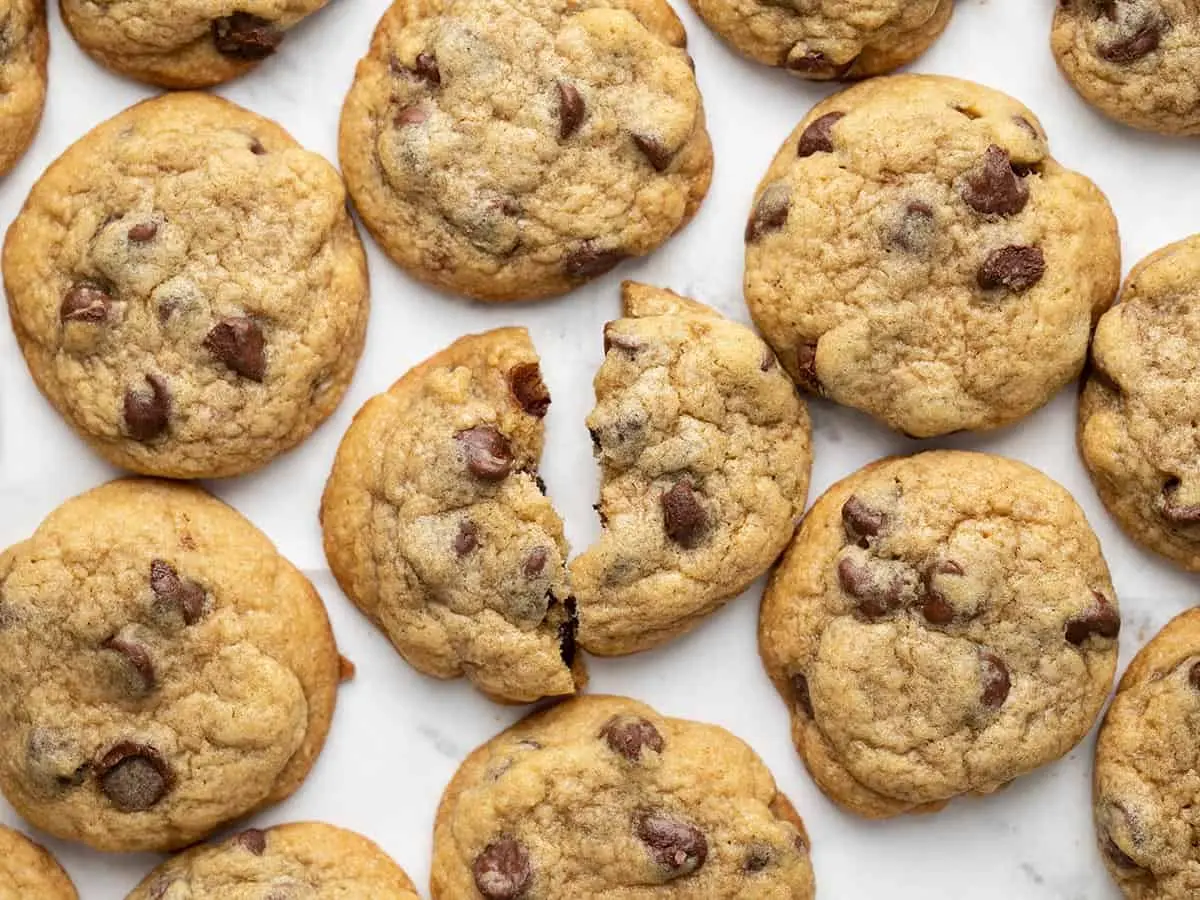
Cookies are more than just delicious treats; they are a testament to culinary creativity, cultural traditions, and technological innovations. From their ancient origins in Persia to modern trends like 3D printing and sustainable ingredients, cookies have evolved in fascinating ways. This collection of trivia highlights the rich history, diverse styles, and enduring appeal of cookies, offering a glimpse into the sweet world of these beloved confections.
Persian Precursors: The earliest cookie-like treats date back to 7th century Persia (modern-day Iran), where bakers crafted flatbreads sweetened with honey and spices. These early cookies, known as “kuhchah,” were enjoyed by the Persians as both a sweet treat and a practical food item that could be stored for longer periods due to the preserving properties of honey. As Persia was a hub of trade and cultural exchange, these early cookies spread to other parts of the world, influencing the development of similar baked goods in various cultures. The use of spices such as cinnamon and nutmeg not only added flavor but also showcased the rich culinary heritage of Persia.
Dutch Treat: The word “cookie” comes from the Dutch word “koekje,” which translates to “little cake.” This term was brought to America by Dutch settlers in the 17th century, who introduced their baking traditions to the New World. Dutch cookies were typically made with butter, sugar, and spices, and were enjoyed as small, sweet treats. The Dutch influence on American baking is significant, as many traditional cookie recipes, such as speculaas and stroopwafels, originated in the Netherlands. Over time, “koekje” was anglicized to “cookie,” becoming a staple term in American English.
Presidential Pastry: The first documented White House cookie recipe dates back to the time of Martha Washington, featuring a crisp molasses cookie. Martha’s recipe, known as “Great Cake,” included molasses, spices, and dried fruits, reflecting the colonial era’s preference for rich, flavorful baked goods. These cookies were likely served at the White House’s social gatherings and state functions, showcasing the hospitality and culinary traditions of America’s first First Lady. The molasses cookie recipe has been preserved as a part of American culinary history, representing the early influence of European baking techniques on American desserts.
Chocolate Chunk Craze: In 1930, Ruth Wakefield, a chef at the Toll House Inn in Massachusetts, accidentally invented the chocolate chip cookie. She intended to make chocolate cookies but ran out of baker’s chocolate and substituted chopped Nestlé chocolate bars, expecting them to melt and blend into the dough. Instead, the chocolate chunks retained their shape, creating the first batch of chocolate chip cookies. This serendipitous invention led to the popularization of chocolate chip cookies, and Nestlé later purchased the rights to Wakefield’s recipe, introducing the Toll House brand of chocolate chips, which remains a household name today.
World’s Largest Cookie: The largest cookie ever baked weighed an astounding 40,000 pounds (18,144 kg) and measured over 25 feet (7.6 meters) in diameter. This colossal cookie was created in 2013 by the Immaculate Baking Company in Flat Rock, North Carolina. It required over 30,000 eggs, 6,500 pounds of sugar, and 6,000 pounds of chocolate chips. The project aimed to break the previous Guinness World Record and promote the company’s commitment to baking with high-quality, natural ingredients. The cookie was baked in sections and assembled on-site, highlighting the ingenuity and scale of this record-breaking culinary feat.
Most Expensive Cookie: The “Millionaire’s Shortbread” by the Scottish bakery Albyn Walker holds the record for the most expensive cookie, priced at £1,800 (around $2,130 USD). This luxurious cookie is made with rare and premium ingredients, including Belgian chocolate, Madagascan vanilla, and edible gold flakes. The shortbread base is rich and buttery, topped with a layer of decadent caramel and high-quality chocolate, making it a truly indulgent treat. The addition of edible gold adds a touch of opulence, making the “Millionaire’s Shortbread” a symbol of extravagance in the world of baking.
Scouting for Sweets: Since 1917, the Girl Scouts of the USA have sold over 9 billion boxes of cookies, with Thin Mints being the all-time bestseller. These cookie sales began as a way for Girl Scouts to fund their activities and programs, and have since become a beloved annual tradition. Thin Mints, a mint-flavored chocolate-coated cookie, have consistently been the top-selling variety, followed by other favorites like Samoas and Tagalongs. The cookie sales teach Girl Scouts valuable skills in entrepreneurship, marketing, and financial literacy, while also fostering community engagement and support.
Presidential Endorsement: In 1984, President Ronald Reagan declared chocolate chip cookies as the official cookie of the United States, although this was not formalized into law. Reagan’s endorsement reflected the widespread popularity and cultural significance of chocolate chip cookies in American society. This declaration helped boost the cookie’s status as a national favorite and reinforced its association with American home baking and family traditions. The chocolate chip cookie, invented by Ruth Wakefield in the 1930s, has since become a quintessential American dessert enjoyed by people of all ages.
Global Phenomenon: Fortune cookies, believed to have originated in San Francisco’s Chinatown in the early 20th century, are now enjoyed worldwide. These crispy, folded cookies contain a slip of paper with a message, ranging from proverbs and predictions to lucky numbers. While often associated with Chinese cuisine in America, fortune cookies were actually inspired by Japanese senbei, a type of rice cracker. The modern fortune cookie was popularized by Chinese-American restaurants, becoming a staple dessert. Today, they are enjoyed globally and have become a symbol of good luck and fun.
Medieval Spice: In medieval Europe, ginger was a popular ingredient in cookies, prized for its warming properties and long shelf life. Ginger cookies, often referred to as gingerbread, were made with a combination of spices like cinnamon, cloves, and nutmeg, along with honey or molasses. These cookies were enjoyed during festive occasions and holidays, and their durability made them ideal for long journeys and storage. The tradition of gingerbread has continued through the centuries, with gingerbread men and houses becoming iconic symbols of Christmas celebrations in many cultures.
Largest Cookie Mosaic: In 2018, a remarkable cookie mosaic featuring the iconic Sydney Opera House was created using over 25,000 homemade sugar cookies. This massive mosaic was assembled in Australia and required careful planning and precise arrangement to accurately depict the world-famous landmark. Each cookie was meticulously decorated to contribute to the overall image, demonstrating both culinary skill and artistic creativity. The project not only celebrated a beloved architectural marvel but also set a new Guinness World Record for the largest cookie mosaic, highlighting the potential of edible art to bring people together for a common cause.
Cookie Jar Astronomy: The term “crumbly” originated in the 17th century and was used metaphorically to describe the moon’s cratered surface, which resembled a broken cookie. This descriptive language reflected the growing interest in astronomy and the detailed observations made possible by advancements in telescopic technology. The term captured the moon’s uneven, rugged terrain, which fascinated astronomers and the public alike. Comparing the lunar landscape to a familiar baked good helped people visualize and relate to celestial phenomena, demonstrating how everyday language can be enriched by scientific discoveries.
National Cookie Day: National Chocolate Chip Cookie Day is celebrated in the United States on May 16th each year, honoring the country’s favorite cookie. This unofficial holiday provides an opportunity for cookie lovers to indulge in freshly baked chocolate chip cookies and to experiment with different recipes. Bakeries, cafes, and home bakers often participate by offering special deals, promotions, and events centered around this beloved treat. The day also celebrates the rich history and cultural significance of chocolate chip cookies, from their accidental invention by Ruth Wakefield to their status as a quintessential American dessert.
Animal Cookies Take Flight: The first animal cracker cookie cutter was created in the 1860s by the National Biscuit Company (now Nabisco), featuring circus animals. These whimsical cookies quickly became popular, especially among children, who enjoyed the fun shapes and the idea of eating edible animals. Packaged in small, colorful boxes designed to look like circus trains, animal crackers became a staple snack in American households. The enduring appeal of animal crackers lies in their nostalgic charm and the playful experience they offer, making them a beloved treat for generations.
Universal Appeal: Cookies are enjoyed in countless variations around the world, each reflecting unique cultural tastes and traditions. In Denmark, buttery Danish butter cookies are a classic treat, often served during holidays and special occasions. In China, chewy mooncakes, typically filled with sweet bean paste or lotus seed paste, are a traditional delicacy enjoyed during the Mid-Autumn Festival. These diverse cookie types highlight the universal love for sweet baked goods and the creativity of bakers in different cultures. Despite their differences, all these cookies share the common goal of bringing joy and comfort through their delicious flavors.
Medieval Luxury: In medieval Europe, spices like cinnamon and cloves were highly prized and often used in luxurious treats for the wealthy, including spice cookies. These spices were expensive and considered exotic, imported from far-off lands through extensive trade networks. Spice cookies, made with a blend of these precious ingredients, were symbols of status and opulence. They were typically enjoyed during festive occasions and special celebrations. The rich, aromatic flavors of these cookies provided a sensory indulgence that was accessible only to those who could afford such luxury, making them a coveted delicacy of the time.
Cookie Jar Chemistry: The Maillard reaction, a chemical reaction between sugars and amino acids, is responsible for the delicious browning and caramelized flavors in cookies. This reaction occurs when the dough is exposed to heat, creating complex flavor compounds and giving cookies their characteristic golden-brown color. The Maillard reaction enhances the overall taste and texture of cookies, contributing to their irresistible appeal. Understanding this reaction helps bakers optimize their recipes and baking techniques to achieve the perfect balance of flavor, aroma, and appearance in their cookies.
Sustainable Sweets: Eco-conscious bakers are increasingly exploring sustainable alternatives for cookie ingredients, such as oat and almond flour, and using upcycled materials like leftover food pulp. These sustainable practices aim to reduce waste, lower the environmental impact of baking, and promote healthier eating habits. For example, using almond flour not only provides a gluten-free option but also repurposes almond meal from almond milk production. Upcycled ingredients add unique flavors and textures to cookies while supporting a circular economy. These innovations reflect a growing trend towards sustainability in the culinary world.
3D Printed Delights: 3D printing technology is being used to create cookies with intricate designs and personalized messages, revolutionizing the way we think about baking. This technology allows for precise control over the shapes and patterns of cookies, enabling bakers to produce custom designs that would be difficult to achieve by hand. From detailed architectural replicas to cookies with names and messages printed on them, 3D printing offers endless creative possibilities. This innovation is particularly popular for special occasions, where personalized cookies can add a unique and memorable touch.
Cookie Dough Craze: Edible cookie dough has become a growing trend, with companies offering safe-to-eat versions that omit the raw eggs typically found in traditional batter. This trend caters to the nostalgic desire to enjoy cookie dough without the health risks associated with consuming raw eggs and flour. Edible cookie dough is often sold in various flavors, with added mix-ins like chocolate chips, sprinkles, and nuts. Some businesses have even created cookie dough cafes where customers can indulge in scoops of cookie dough served like ice cream. This trend highlights the playful and comforting appeal of raw cookie dough in a safe and delicious form.
Cookie Decorating Extravaganza: Elaborately decorated cookies have become a popular art form, with competitions and online communities dedicated to showcasing creative cookie artistry. These cookies often feature intricate designs, hand-piped icing, and detailed decorations that can take hours to complete. Competitions like the National Cookie Cutter Collectors Club contests and platforms like Instagram and Pinterest have elevated cookie decorating to new heights, inspiring bakers to push the boundaries of their creativity. From holiday-themed cookies to personalized designs for special occasions, decorated cookies are not only delicious but also visually stunning, transforming simple treats into edible works of art.
The Great British Bake Off: The popular baking competition show, “The Great British Bake Off,” has significantly increased the popularity of technical baking challenges, including perfect cookie creation. Contestants on the show are tasked with making a variety of cookies, from delicate biscuits to complex layered creations, under time constraints and with high standards for precision and flavor. The show has inspired home bakers around the world to improve their baking skills and try their hand at new recipes and techniques. The emphasis on both technical ability and creativity has made cookies a focal point in the baking community, celebrated for their versatility and potential for innovation.
Cookie Jar Classics: The iconic glass cookie jar, often decorated with a cartoon image of a cookie monster, became a popular household item in the 20th century. These jars were designed to store cookies and keep them fresh, while also serving as a decorative element in kitchens. The cookie jar became a symbol of home and comfort, often filled with homemade treats that were readily available for family members and guests. Over time, cookie jars have become collectible items, with vintage and novelty designs fetching high prices among collectors. The cookie jar represents a nostalgic piece of Americana, evoking memories of childhood and family gatherings.
Cookie Sharing Culture: Sharing cookies is a common way to show hospitality and spread cheer, fostering a sense of community and connection. Whether it’s bringing a plate of cookies to a neighbor, sharing a batch with coworkers, or exchanging holiday cookies with friends and family, these sweet treats often serve as a gesture of goodwill and friendship. Cookie swaps and bake sales are popular social events that encourage people to share their favorite recipes and enjoy a variety of baked goods. This tradition of sharing cookies helps build relationships and create lasting memories, reinforcing the idea that food can bring people together.
The Science of the Perfect Bite: The ideal cookie should have a balance between a crisp exterior and a chewy interior. Achieving this perfect texture involves understanding the Maillard reaction, which creates browning and caramelization on the outside, and controlling the ratio of flour to wet ingredients in the dough. Baking time and cooling methods also play crucial roles; shorter baking times and immediate cooling can result in chewier centers, while longer baking times and gradual cooling lead to crisper textures. Experimenting with these variables allows bakers to customize their cookies to their preferred texture, ensuring that each bite offers the perfect combination of crunch and chew.
5 FAQs About Cookies (the Delicious Kind!)
What are the different types of cookies?
There are many varieties of cookies, but some of the most common types include:
Chocolate Chip Cookies: A classic favorite, made with butter, flour, sugar, eggs, and chocolate chips. Variations include oatmeal chocolate chip, peanut butter chocolate chip, and white chocolate chip.
Sugar Cookies: Simple and versatile, sugar cookies can be enjoyed plain, frosted, or decorated. They are often cut into shapes for holidays or special occasions.
Snickerdoodles: These soft cinnamon sugar cookies have a slightly tangy flavor due to the use of cream of tartar.
Shortbread Cookies: Shortbread cookies are known for their crumbly texture and buttery flavor. They are often simple and may be flavored with lemon or nuts.
Oatmeal Raisin Cookies: Chewy oatmeal raisin cookies are packed with oats, raisins, and often spices like cinnamon and nutmeg.
How can I store leftover cookies?
The best way to store leftover cookies depends on how soon you plan to eat them:
Short-term storage (up to 3 days): Store cookies in an airtight container at room temperature. This will help them stay soft and chewy.
Longer-term storage (up to a week): Store cookies in an airtight container in the refrigerator. Cold temperatures can make cookies a bit firmer, but they will still be delicious.
Long-term storage (beyond a week): Freeze your cookies in an airtight container. They can be stored in the freezer for several months. Thaw them at room temperature before enjoying.
How can I keep my cookies soft?
Store them properly: Use an airtight container to prevent cookies from drying out.
Revive them with moisture: If your cookies have become a bit hard, you can try placing a slice of apple or a piece of bread in the container with them. The moisture will soften the cookies up a bit.
Reheat them briefly: You can refresh the texture of cookies by warming them in a low oven for a few minutes.
Can I freeze cookie dough?
Yes, you can freeze cookie dough! This is a great way to have fresh cookies on hand whenever you crave them. Here are two options:
Freeze scooped dough balls: Scoop the cookie dough and place them on a baking sheet in the freezer for a few hours. Once frozen, transfer the dough balls to a freezer-safe storage container.
Freeze shaped dough logs: Shape the cookie dough into a log, wrap it in plastic wrap, and then in foil. Freeze the dough log for up to 3 months. Slice and bake the dough whenever you’d like fresh cookies.
What are some fun ways to decorate cookies?
Cookie decorating is a fun activity for people of all ages! Here are some ideas:
Frosting: Use different colored frostings to create designs or write messages.
Sprinkles: Sprinkles come in all sorts of colors and shapes, and they’re a great way to add some fun and festivity to your cookies.
Candy: Chopped candy bars, candies like M&Ms or peanut butter cups, and even gummy candies can be used to add pops of color and flavor to your cookies.
Chocolate: Drizzle melted chocolate over your cookies, or use chocolate chips or candies to create designs.
Nuts: Chopped nuts can add a nice textural contrast to cookies.
Edible glitter or sanding sugar: For an extra sparkly touch, use edible glitter or sanding sugar.








